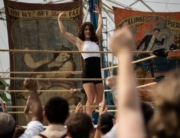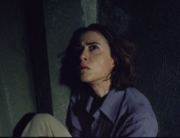Director Jeff Nichols’s reverent but reserved biopic of Mildred and Richard Loving’s legal showdown, appropriately titled Loving, gives credit where credit is due—to another filmmaker: Nancy Buirski. Her 2011 documentary, The Loving Story, premiered at the Tribeca Film Festival and aired on HBO. Both films recount the lead-up to the 1967 Supreme Court decision Loving v. Virginia, which struck down anti-miscegenation laws. Buirski is one of the producers of Nichols’s feature film, and her account of the groundbreaking case has been singled out by Loving producers Ged Doherty and Colin Firth (yes, the actor) as the inspiration for this film.
Her version makes sense of the legal labyrinth the married couple had to sort through, while illuminating the time and place of Jim Crow Virginia. Additionally, the subjects’ personalities as individuals shine through the copious photos and contemporaneous documentary footage. The thoroughness of Buirski’s film creates a challenge for Nichols: Why depict the Lovings’ ordeal in a feature? The answer is not really crystal clear, especially since Buirski told her version in nearly half the running time as Nichols’s.
Some background: Mildred Jeter was 17 when she married Richard in June 1958 in Washington, DC. She was of African and Native heritage, while Richard, a carpenter, was white and looked like a redneck straight out of Central Casting, a freckled towhead with a buzz cut and a solid build. Both were from sharecropping families in rural Central Point, VA. Though she later admitted to knowing the breadth of the segregation laws, she wasn’t aware that they would extend to her marriage.
A month later, a Caroline County sheriff barged into their home in the middle of the night and arrested them for breaking the state’s Racial Integrity Act, which outlawed interracial marriage, and threw them in jail. They pleaded guilty, and the judge suspended their sentence if they would leave the state as they were married. They accepted the plea bargain, causing them to separate from their families and their lifelong homes. It was Mildred’s straightforward, polite letter to U.S. Attorney General Robert Kennedy in 1963 that eventually brought the couple’s plight to the attention of the American Civil Liberties Union.
Those familiar with the case—even if the details are fuzzy—will likely find the film a dutiful and sober retelling. For others who find the circumstances eye-opening, if not shocking, they are still less likely to leave feeling indignant, namely because the film doesn’t make such demands from viewers. Significantly, the overall tone is less defiant but restrained, bordering on resignation.
That’s partially due to the real-life Lovings. Their portrayal here mirrors what one discovers in the documentary: they are soft spoken, if not timid. Richard was by most accounts a man of little words, but the uncommunicative, sleepy-eyed, hang-dog portrayal by Joel Edgerton comes dangerously close to another misunderstood country boy, Lennie in Of Mice and Men. (Indeed, Richard seems to want to sink into the background.) The soft-spoken Mildred (Ruth Negga) was far more articulate and became the spokesperson for the two.
More crucially, Nichols’s direction downplays the inherent drama. When Mildred returns to Virginia to give birth to her first child (so that Richard’s mom would be the midwife), she is arrested. When the sheriff arrives, Mildred’s extended family is present as the lawman arrests, handcuffs, and escorts her away. The reaction of the ensemble—folding their arms and looking on and remaining rather calm, considering the humiliation—contains little sense of injustice. The depiction may be true to life, but it’s deadening to drama, which here is mainly situational.
Tensions flare here and there from the stares of townsfolk in reaction to the couple’s public displays of affection. Later on, as the legal case makes its way through the courts, Richard finds on his car’s front seat a brick wrapped in a copy of the LIFE Magazine 1966 article, “The Crime of Being Married,” which sympathetically profiled the Lovings. Yet in The Loving Story, Mildred mentions that someone burned a cross on her mother’s front yard—an incident that’s oddly omitted here.
In so many ways, the film is this year’s Spotlight, another re-creation of the righting of a wrong—the movies focus on different issues but have a similarly hushed, just-the-facts, plainspoken approach. But at least that film had Mark Ruffalo delivering a grandstanding monologue, which gave the drama a rush of adrenaline. Nichols’s script refrains from making any sweeping statements, and even the racist sheriff is portrayed with understatement by Marton Csokas. (It’s noteworthy that most of the lead actors in this quintessentially American story are not American.) The overall effect is as though Nichols is preaching to the choir—not boisterous and soul-baring Baptist but contemplative and formal Episcopalian.
Loving comes across as mild and conventional considering the current climate and the director’s last film, the Bible Belt–set and slightly bonkers sci-fi flick Midnight Special. For a more visceral and expansive film experience, Ava DuVernay’s knotty, connect-the-dots documentary, 13th, is currently streaming on Netflix. It traces the shared history of African Americans, the law, and the country’s explosive prison population, from post-Reconstruction to the War on Drugs. It points out how numerous post-slavery laws, such as the once widespread anti-miscegenation regulations, were passed to marginalize and criminalize blacks, particularly in the South. Here history feels immediate and stirring.

















Leave A Comment